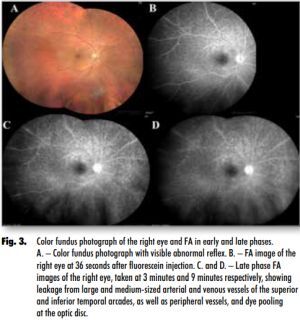Current issue
Archive
Online first
About the Journal
Editorial Board
Scientific Board
Reviewers
Abstracting and indexing
Publisher
Contact
Subscription
Ethical standards and procedures
Abstracting and indexing
For authors
Ethical standards and procedures
Publication charge
Books and Events
Books
Events
RESEARCH PAPER
Syphilitic Chorioretinitis – two case Reports and Literature Analysis
1
Division of Ophthalmology and Optometry, Department of Ophthalmology, Collegium Medicum, Nicolaus Copernicus University, Bydgoszcz, Poland
2
Oftalmika Eye Hospital, Bydgoszcz, Poland
3
Department of Sensory Organ Studies, Nicolaus Copernicus University, Collegium Medicum in Bydgoszcz, Bydgoszcz, Poland
Submission date: 2023-10-22
Acceptance date: 2023-12-01
Publication date: 2023-12-29
Ophthalmology 2023;(4):8-11
KEYWORDS
ABSTRACT
Introduction: Syphilis, a systemic, sexually transmitted inflammatory disease caused by Treponema pallidum, presents challenges in diagnosis due to its varied manifestations. Ocular syphilis often presents with non-specific symptoms. This study aims to elucidate the diagnostic process through the analysis of two patient cases, including one with HIV co-infection. Material and Methods: The study evaluated two ocular syphilis cases, diagnosed using comprehensive treponemal (fluorescent treponemal antibody absorption test, Treponema pallidum hemagglutination assay, enzyme immunoassay) and nontreponemal (venereal disease research laboratory test, rapid plasma reagin test) testing. Factors such asuveitis symptoms, sexual behavior, drug use, previous treatments, and available medical history were considered. Results: The results highlight the complexity of ocular syphilis diagnosis. Both cases underscored the need to include ocular syphilis in differential diagnoses for eye infections or inflammations, especially in patients with high-risk behaviors, drug use, or a history of syphilis. The non-specific nature of symptoms necessitates comprehensive testing for accurate diagnosis. Conclusions: This study reinforces the importance of considering ocular syphilis in the differential diagnosis of inflammatory eye diseases. A meticulous approach combining both treponemal and nontreponemal tests is crucial for accurate diagnosis. These findings emphasize the need for thorough clinical evaluation and history-taking in patients presenting with ocular symptoms.
Share
RELATED ARTICLE
We process personal data collected when visiting the website. The function of obtaining information about users and their behavior is carried out by voluntarily entered information in forms and saving cookies in end devices. Data, including cookies, are used to provide services, improve the user experience and to analyze the traffic in accordance with the Privacy policy. Data are also collected and processed by Google Analytics tool (more).
You can change cookies settings in your browser. Restricted use of cookies in the browser configuration may affect some functionalities of the website.
You can change cookies settings in your browser. Restricted use of cookies in the browser configuration may affect some functionalities of the website.




